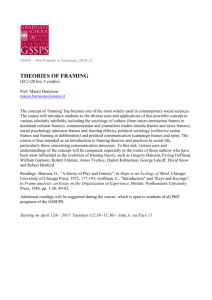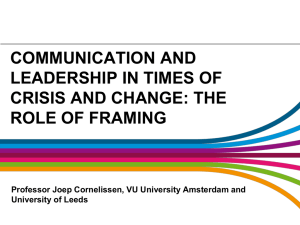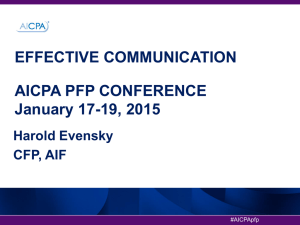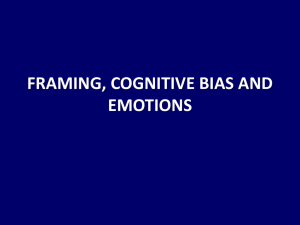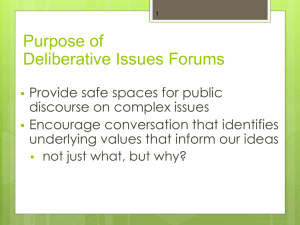The Construction of Frames in News Journalism
advertisement
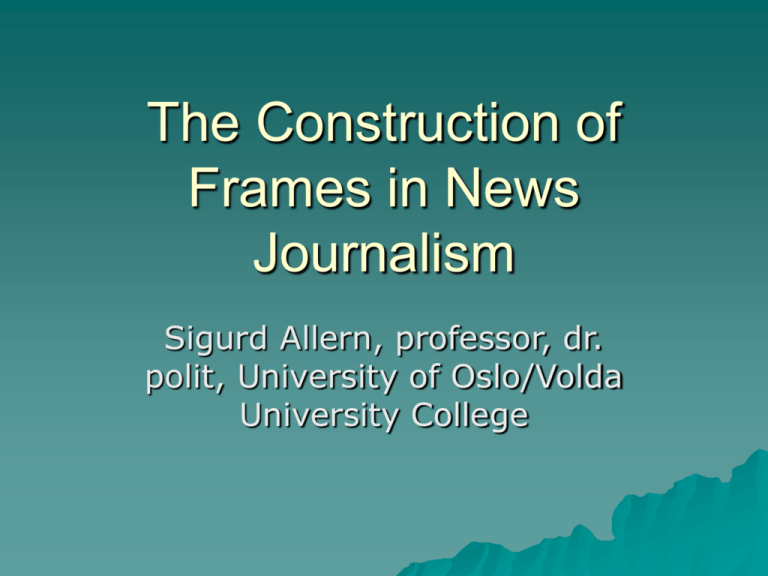
The Construction of Frames in News Journalism Sigurd Allern, professor, dr. polit, University of Oslo/Volda University College Framing theory Framing theory - or theories about framing today represent one of the most common research approaches in the field of communication and media studies. The origins of the frame metaphor lie in other fields like cognitive psychology, anthropology (Bateson) and sociology (Goffman). A frame specifies the relationship between a number of connected elements in a text, helping us to define or interpret what is going on, making sense out of events Why words matters Experimental studies by cognitive psychologists: choices between risky projects can be powerfully altered merely by changing the terms in which equivalent choices are described. (“Will die” or “will be saved”) Preferences for tax policies can be manipulated by framing the financial outcomes differently (benefits or penalties?). Surgery as cancer treatment: use statistics in terms of survival rather than mortality! A Swedish example Expressen (18.9.2001): 47% against US attack in Afghanistan. DN (27.9.2001): “Seven out of ten support US attack” Expressen’s question: Do you find it right wrong that the US invade Afghanistan with military troops? DN’s question: Do you find it right or wrong of prime minister Persson and the other prime ministers to support the US’s right to attack? Media frames (Todd Gitlin, 1980) “What makes the world beyond direct experience look natural is a media frame”. “Frames are principles of selection, emphasis, and presentation composed of little tacit theories about what exists, what happens and what matters” “Thus for organizational reasons alone, frames are unavoidable, and journalism is organized to regulate their production” Gaye Tuchman: News as frame News is a window of the world. Through its frame, American learn of themselves and others, of their institutions, leaders, and life styles, and those of other nations and their peoples… …The view through a window depends upon whether the window is large or small, has many panes or few, whether the glass is opaque or clear, whether the window faces a street or a backyard. (Making News, 1980) Defining framing “Frames are organizing principles that are socially shared and persistent over time, that work symbolically to meaningfully structure the social world” (Stephen D. Reese (2001: 11) in Reese, Gandy & Grant (eds.): “To frame is to select some aspects of a perceived reality and make them more salient in a communicating text” (Robert Entman 1993: 52) “The essence of framing is selection to prioritize some facts, images or developments over others, thereby unconsciously promoting one particular interpretation of events (Norris, Kern & Just 2003) How frames work “The frame suggests what the controversy is about, the essence of the issue” (Gamson & Modigliani 1989, in Vreese: 27) Frames are ..interpretative packages that give meaning to an issue (Gamson & Modigliani, 1989: 3) Framing involves implicit information between the lines, the frame provides a context for the interpretation of a news message Journalistic tools in framing the news Choosing the news angle Selecting the sources (and avoiding others) Formulating the headline, the lead of a news story and selecting the visual image Culture bound narratives: formulating a new episode in a longer and well known story. Choosing the news angle Journalistens vinkling kan sammenlignes med: ”…en tøjsnor, hvor kun de relevante stykker information er hængt til tørre, og den hjælper på den måde journalisten at strukturere informationerne omkring en central ide og er dermed også med at koncentrere læserens opmærksomhed om de udvalgte sider av emnet.” Mogens Meilby (1996): Journalistikkens grundtrin. Århus: Ajour. Framing contests The frame building process takes place in a continuous interaction between journalists and elites and social movements. The outcomes of the frame-building process are the frames manifest in the text (Vreese 2003: 24, 43) If politicians or PR-practitioners are to succeed getting their frames wholly or partly presented in the media, they have to adhere to certain news conventions and genre demands from commercial news organisations giving priority to conflicts, power struggles and drama (Allern 2001, Ihlen & Allern 2007) Frames are part of a culture.. “Frames are part of a culture and are institutionalized in various ways” (Goffman 1981, p 63). Van Gorps (2007) six premises: 1 There exist a cultural stock of frames, alternatives are available (like in Vladimir Propps Morphology of the folk tale) 2 The text and the frame is not identical; the readers connect framing devices in a news story with familiar cultural phenomena ..the cultural approach 3 The use of frames seem normal, natural and the social construction are often invisible. Frames as a power mechanism. 4 Frames are part of the culture, more stable than personal schemata 5 A frame changes gradually or little over time 6 Frames are negotiated and part of a social interaction Frames are not the same as topics Topic: Asylum seekers and undocumented immigrants Alternative frames (van Gorp 2007): Misgovernment frame Intruder/strangers frame Our hospitality frame The innocent victim frame The donor/support frame The “not in my backyard” frame Frames as regular patterns “Through frames, apparently scattered and diverse events are understood within regular patterns… ..the terrorist frame can be used to explain the nightclub attack in Bali, the Chechen rebels holding hostages in the Moscow theatre, the bombing of Israel tourists in a Mombassa hotel, the suicide bombers in Tel Aviv, or the capture of communist insurgents in the Philippines (Norris, Kern & Just 2003: 11). Bali, Moscow Theatre, Mombasa hotel: The same Story? Framing early student protest against the war against Vietnam (1965) Todd Gitlin: The whole world is watching (1980): analyzing the earliest framing devices in main stream media outlets. “15000 White House pickets denounce Vietnam War” Framing devices in coverage of Vietnam protests Trivialization (of age, dress, language, style, goals) Polarization (emphasizing counterdemonstrations) Emphasis on internal dissention Marginalization (deviant or unrepresentative) Disparagement by numbers (under-counting) Reliance on statements by government officials Framing the WTO “A few Starbucks windows smashed by a hundred ‘anarchists’ where all the shallower news reports needed to see to decide “what’s the story”, even if tens or hundreds of thousands of demonstrators were marching by playfully, in peace” (Todd Gitlin about Seattle 1999) Contrasting guilt and innocence Robert Entman (in Projections of Power, 2004), comparing the media coverage of a Soviet Air Force Fighter who shot down Korean Air Flight 007 (1983, killing 269 people) and the coverage of a US Navy Ship (Vincennes) who in 1988 shot down an Iranian Air Flight 655 (killing 290). The media framing varied dramatically. Soviet covered with “the murder frame”, US by the “technical glitch frame”. Contrasting magnitude, causes and the use of humanizing or neutral terms (quantitatively) Episodic or thematic framing? Shanto Iyengar (1991): Is anyone responsible? How television frames political issues. Predominantly episodic or thematic news stories in CBS, NBC and ABC. Key word search of different topics (like crime and terrorism, unemployment and poverty). Experimental study: how did did the groups react to different types of framing? Conclusion: In the long run episodic framing contributes to the trivialization of the public discourse Framing a scandal: The Valla case A personnel conflict inside the national trade union (the LO). A international secretary decide to leave her job Background: political conflicts inside the LO and the Labour party A dramatically press campaign (war and tsunami proportions) follows. After two month the LO-leader, GerdLiv Valla resigns The mother and the teddy bear.. Competing frames in the Valla-case The harassment frame The power-struggle frame The revenge frame Framing the EU All news actors know that geographical and cultural proximity will increase the audience interest for a news story EU journalism is structured within national practices “I have to, in effect, get Ireland into the first two paragraphs, that’s my rule of thumb” (Irish correspondent) • AIM-study 2007 (Interview-study): Reporting the EU from Brussels): Framing the Tibet conflict The peaceful, democratic buddhist frame (visualized by the ever smiling Dalai Lama) The tibetan David against the Chinese Goliat frame (monks against brutal soldiers/policemen) Framing Tibet in Chinese media The Tibetan separatist- extremist frame (obstructing the united China) The Tibetan hooligan frame (harassment and plundering in Lhasa) The tragic death of Obiora Eugene E. Obiora (48), denied to leave a social office in Trondheim. Arrested by four police officers. A dangerous throat grip was used. Lost consciousness. Transported handcuffed, with his face down and feet up, to hospital. He died. Framing the Obiora-case The legal action frame: A necessary, legal action against an aggressive, strong man. The throat grip and type of transport was standard procedure. Because of unlucky circumstances he died. No police officer can be blamed The racism frame: A violent action against an unarmed social client with black skin. Treated especially brutal because he was of foreign (African) origin. The police officers should be punished “State racism kills..” The ‘police frame’ influence and succeed in the legal process (the case was in 2007 dismissed by the Director of public prosecutions) The ‘racism frame’ dominated the press coverage and the public debate The Ali Farah case (2007) News picture of the year A new case of racism? A seriously injured man (head damage after an attack) is denied access to a hospital ambulance because he pees on himself and on a driver. He is abused by the drivers, who leave. The treatment is linked to the Obiora case, and after some days framed in the news (and by activists and leading politicians) as a tragic example of problems with racism in the public sector The racism frame is contested and debated Reframing of the case The two drivers get warnings because of maltreatment and are also fined by the authorities A-magasinet/Aftenposten 2008: The driver is “a labelled man”. The driver: We did a mistake, but I am not a racist” Reframing the case as an unlucky accident. Successful in the media. One of the drivers won a court case about the fine. Methodological alternatives Qualitative textual (discourse) analysis of framing devices and latent meaning structures. Quantitative content analyses of manifest variables (like predefined framing devices) Experimental studies of effects of different types of framing Interviews with journalist, frame sponsors and audience members about the construction and negotiations of frames Conclusion: Framing matters! Literature Carver, R, R. Waldahl & J. Breivik(2008): ’Frame that gene’, EMBO reports. De Vreese, Claes (2003): Framing Europé. Television News and European Integration, Amsterdam: Aksant Entman, R. (1993): ’Framing. Toward Clarification of a Fractured Paradigm’, Journal of Communication 43 (4): 51-58 Entman, R. (2004): Projections of Power, Chigcago, University of Chigago Press Gitlin, T. (1980): The Whole World is Watching.. (Berkely..: Universityof California Press) Goffman, E. (1974): Frame Analysis, Cambridge: Harvard University Press Ihlen, Ø & S. Allern (2008): ’This is the Issue: Framing Contests and Media Coverage’, in Strömbek, Ørsten & Aalberg (eds.): Communicating Politics, Gothenburg: Nordicom. Iyengar, S.: (1994): Is anyone responsible. How television frames political issues, Chcago: University of Chicago Press Norris P., M. Kern & M. Just (2003): Framing Terrorism, New York/London: Routledge Reese, S.D., Gandy O.H. & Grant, A.E (eds.) (2001): Framing Public Life: Perspectives on Media and Our Understanding of the Social World. Mahwaa, NJ: Lawrence Erlbaum. Tuchman, G. (1978): Making News. A Study of the Construction of Reality, New York: Free Press Van Gorp, B (2007): ’The Constructionist Approach to framing: Bringing the Culture back’, Journal of communication, 57 (1): 60-78

